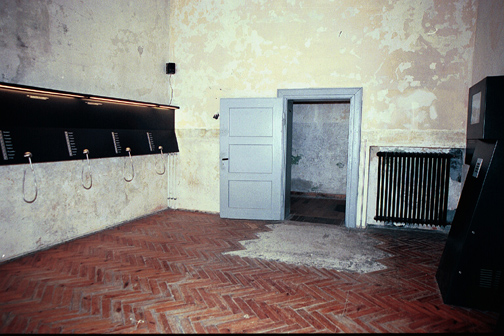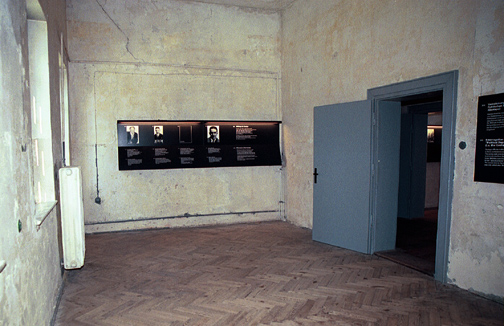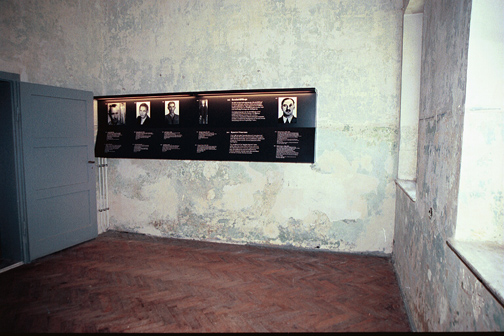Exhibits inside the bunker at Dachau"The most important department, though it appears subordinate to the camp commander, was the Political Department. This department was under the command of Kick, Johann (Kriminal Sekretar, SD Untersturmführer, Head of STAPO Aussenstelle in Dachau), who was in contact with Berlin, and it was this department's function to check and counter-check not only the camp commander's activities with the orders that the camp commander received from higher authorities, but to investigate the activities of all departments at Dachau." Appendix B of The Official Report by the U.S. Seventh Army, Dachau Concentration Camp, May 1945  When I visited the Dachau Memorial Site in 2001, the entrance into the exhibits in the bunker was through a door in the center of the north side of the long building. Inside, there was a hallway with a map of the building which identifies four rooms that were open to the public. The first room that I saw was to the right of the entrance. It is a 20 by 15 foot room that was formerly the day room for the SS guards and the office of the SS chief duty officer. This room is shown in the photograph above. On the walls in the day room were photographs of the former wardens and guards in the prison. According to the exhibit, there were two men who were exceptionally cruel: Johann Kantschuster, a warden from 1933 to 1939 and Josef Seuss who was a guard from 1933 to 1937 and then a warden from 1938 to 1942. Kantschuster disappeared in 1945 and was never brought to trial as a war criminal. Josef Seuss was convicted by an American Military Tribunal at Dachau on a charge of participting in a "common plan" to commit war crimes; he was executed at the Landsberg am Lech prison in May 1946. According to the exhibit in the day room, shown in the photograph above, there were no accusations of cruelty against Edgar Stiller by the prisoners. Stiller was on the staff from 1941 to 1943 and was put in charge of "special prisoners" between 1943 and 1945. On April 26, 1945, Stiller was in charge of the evacuation march of the VIP prisoners to the South Tyrol; he turned all the VIP prisoners over to Captain Payne-Best, who was one of the prisoners, to prevent them from being executed as allegedly ordered by Reichsführer-SS Heinrich Himmler. In spite of having no accusations of mistreatment against him, and in spite of saving the VIP prisoners from certain death, Stiller was put on trial by an American Military Tribunal at Dachau in 1947. He was convicted of participating in a "common plan" to commit war crimes and sentenced to 7 years in prison, but he was released in 1950. The exhibit in the room pictured above says that Johann Kick was the head of the Gestapo department at Dachau from 1937 to 1945. At the first American Military Tribunal proceedings against 40 Dachau staff members , Kick was accused of torturing prisoners to get confessions. He was convicted and executed in 1946. At his trial, Kick testified that the American military interrogators had tortured him to get him to sign a confession. Appendix A of the official US Seventh Army report, entitled Dachau Concentration Camp, states the following: Kick, Johann - SS Untersturmführer - Former chief of the Political Department of the Dachau Concentration Camp, head of the STAPO Aussenstelle Dachau, Kick related that he entered the Political Department of the Dachau Concentration Camp on 20 May 1937 as a hearer of cases, and that in January 1938, he was named Chief of the department by SS Sturmführer Beck, Oberregierungsrat of the Gestapo, Munich. He held this position until August 1944, when he was put in charge of STAPO Aussenstelle Dachau. In his new position Kick was charged with recruiting espionage agents from the Dachau Concentration Camp. He relied almost wholly on intimidating and coercive methods. The room where incoming prisoners were registered is on the left as you enter the hallway in the bunker. In 1944, Dr. Lothar Rohde occupied the registration room as a prisoner. Across the hall from the registration room is the former medical examination room, where Dr. Rohde's wife was also a prisoner in 1944. The exhibit does not mention why Dr. Rohde was arrested. The photograph below shows the former registration room which had ear phones in 2001, where visitors could listen to a recording about the bunker.  The interrogation room shown in the photograph below is next to the medical examination room. It is 20 by 12 feet and has three large windows. Notice the oak floor laid in a chevron pattern, and the radiator for central heating on the wall on the left side. A door was added later so that visitors can now walk into the adjoining room.  In 2001, a sign in the interrogation room informed visitors that this room had double doors and cavity walls to prevent cries from being heard as the prisoners were tortured. There was no mention of exactly how the prisoners were tortured. From 1943 to 1945, the room shown in the photo above was the prison cell of Richard Stevens, who was arrested at Venlo in Holland on November 9, 1939, along with Captain S. Payne-Best on a charge of conspiring to assassinate Hitler and overthrow the German government. The exhibit glosses over the alleged assassination attempt and does not mention why Stevens was arrested. Both Stevens and Payne-Best were initially imprisoned at Sachsenhausen, but Payne-Best was later transferred to Buchenwald. Richard Stevens and Payne-Best were among the VIP prisoners who were taken to the South Tyrol on April 26, 1945 three days before the American liberators arrived. After the war, Stevens publicly complained of the treatment he had received at the hands of the Nazis, but his co-conspirator, Captain Payne-Best, wrote a letter in which he claimed that Stevens got better treatment than he did. In April 1945, Captain Payne-Best was brought from Buchenwald to Dachau just before the Buchenwald camp was liberated by American soldiers. In his memoirs, Captain Payne-Best wrote that Dr. Sigmund Rascher confessed to him that prisoners were gassed at Dachau. He claimed that he had met Dr. Rascher at Buchenwald, but testimony at the Nuremberg IMT revealed that Dr. Rascher was held in a Munich jail before he was sent to Dachau. Dr. Rascher was the man who had been in charge of conducting medical experiments at Dachau for the German Air Force, before he was arrested and charged with illegally claiming someone else's children as his own.  The exhibits in the bunker tell the stories of some of the Dachau inmates who were imprisoned here. For example, one of the featured inmates is a Jewish economist from Munich, Heinz Dietrich Feldheim, who was arrested as an anti-Nazi in June 1936 and brought to Dachau. He was imprisoned in the bunker from June 1937 until September 1938 when he was transferred to the Buchenwald concentration camp. After he was released from Buchenwald in April 1939, he moved to Great Britain. Another Jewish prisoner in the Dachau bunker was Dr. Albert Rosenfelder who was arrested in March 1933. He was sent to Dachau on April 13, 1933, but "disappeared" in October 1933, according to the exhibit. The exhibit mentions that he was the one who got Julius Streicher imprisoned in 1929, but does not provide any more details about the case. An article which I found on the Internet says that Streicher was found guilty of "libeling the Jewish religion under Paragraph 166 of the Weimar Penal Code." Streicher was a well known hate-monger who published an anti-Semitic newspaper; he was convicted as a war criminal at the Nuremberg IMT and executed. According to the bunker exhibit, on May 18, 1933 Louis Schloss, a Jewish prisoner, was murdered by hanging in his cell. Interior of prison cellsPreviousBack to Dachau Concentration CampBack to Table of ContentsHomeThis page was last updated on July 12, 2012 |